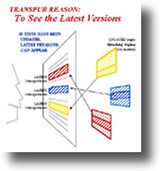Transpublishing
* This laboratory has been completed.
The Transpublishing project aims to get a system in operation to enable easy publication of contents on a network, automatic processing or reuse of copyrights, a system that enables royalty payments in a very small amounts, as well as to develop a multi-dimensional data structure [ZigZag] as a new base appropriate for effectively processing and displaying software, applications and complicated information on personal computers and mobile devices.
| Number of participating organizations | 2 |
|---|---|
| URL | http://tps.iprs.sfc.keio.ac.jp |
| Contact |
Kenji Naemura
E-mail:naemura@sfc.keio.ac.jp |

Background
The transcopyright system that Professor Theodor Nelson proposed in the Xanadu project enables publication and reuse of content on a network (trans-quotation). Although hyperlinks for the web were developed based on this, its critical disadvantage is that it is unable to process copyrights, which requires implementation of a system for granting copyrights on a web.
However, to accumulate, access, display and process different bits of multimedia information on a network environment by cross-referencing them, a versatile and flexible data structure is necessary which, however, has been difficult to implement on the Windows platforms and web. To effectively handle the cross relationship of such complicated information structures, a system based on extended 2-dimensional structures and a multi-dimensional data structure must be implemented. “ZigZag” proposed by Professor Nelson may be used as this base.
Features
The transcopyright system enables reuse of original literary works by adding a tagging function for transquotation to HTML and by describing the copyright granting conditions. The developed “hypercoin”(micro payment) system has a characteristic that balances security protection and necessary costs by employing a two-level authentication system. Currently, mainstream relational databases and spreadsheet applications are suited for processing two-dimensional structures consisting of rows (attributes) and columns (tuple). But there are many pieces of information that are not suited to being handled in two-dimensional structures in an actual society such as long family histories or world history chronologies. One of the features of ZigZag is that it can handle multi-dimensional data structures by expanding
Challenges
To practically use copyright processing in the transcopyright system, it is necessary to improve the user interface for the trans-quotation implemented for the first time in HTS V.1, improvement in performance and in linking method with the “hypercoin”(micro payment) system to develop HTS V.2. At the same time, a typical business model using HTS V.2 must be clarified. Also, to apply the possibilities of ZigZag to businesses, it is important to seek and demonstrate applied examples. It is necessary to develop a ZigZag application environment including a function for displaying wide variety of information on the display in a form appropriate for specific objectives.
Status of activites
The basic model of the transcopyright system has been developed by “hyper transaction system”, a collection business by MITI and it already has been published as a free software (HTS V.1). Currently a prototype of “hypercoin” developed independently by Professor Nelson as a micro payment system required for granting a copyright is being created in Australia. A prototype version of a core portion of ZigZag has been developed and published in Finland.
Research plan
At first, an operational system shall be developed by 2001 and subjected to demonstration experiments to contribute to getting it out to businesses. Next, its functions will be expanded in 2002.
Expected results
By combining the transcopyright system and the hypercoin system, anyone can then publish content on a network and to receive payments from users as part of e-commerce, and a system will be put in operation as ideal for many-to-many trade system which allows easy reuse of content. Application fields may include: multimedia material, e-publication for academic fields, law information, travel & local information, new information, etc. ZigZag is expected to greatly grow as a new platform for organically linking data handled with personal computers or mobile devices with those at computer centers in order to do extensive searches. It may find various uses, e.g. as an e-mail organizer, for accessing information via mobile phones, for managing projects, accessing information in genealogy, historical sciences, various materials or medical information.
Researchers, managers and professors
| Kenji NaemuraDirector | Professor, Graduate School of Media and Governance |
|---|---|
| Hajime Ohiwa | Professor, Faculty of Environmental Infomation(*) |
(*) Renamed to "Faculty of Environment and Information Studies" in 2007